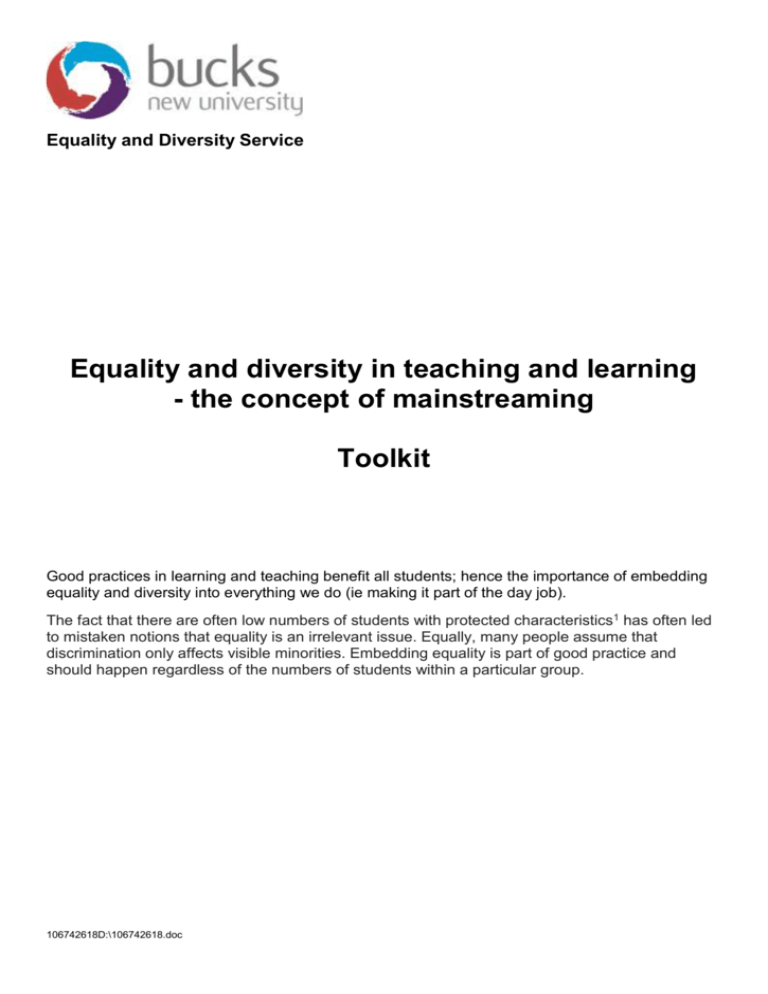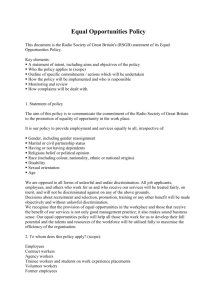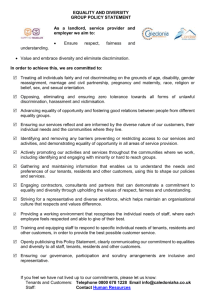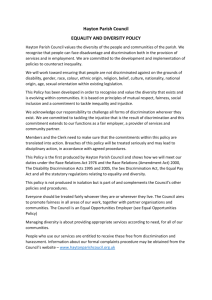the concept of mainstreaming
advertisement

Equality and Diversity Service Equality and diversity in teaching and learning - the concept of mainstreaming Toolkit Good practices in learning and teaching benefit all students; hence the importance of embedding equality and diversity into everything we do (ie making it part of the day job). The fact that there are often low numbers of students with protected characteristics1 has often led to mistaken notions that equality is an irrelevant issue. Equally, many people assume that discrimination only affects visible minorities. Embedding equality is part of good practice and should happen regardless of the numbers of students within a particular group. 106742618D:\106742618.doc Equality and diversity in teaching and learning should be delivered by mainstreaming these issues into the curriculum. Equality and diversity has to be embedded into all aspects of the curriculum: from lesson planning and teaching methods to assessment procedures; from inclusive resources and materials to teaching which focuses on discrimination, harassment and victimisation on the grounds of the 9 protected characteristics1 under the Equality Act 2010. Effective mainstreaming will happen when equality and diversity permeates every aspect of curriculum design, planning, and delivery. It is not occasional ‘good practice’ simply bolted on to what usually happens in the classroom. Consider the following checklist: • • • • • • Do you ensure that students who belong to groups that face discrimination are not marginalised and can find appropriate reflections of their experiences and identities within the curriculum (e.g. inclusive resources, texts, images, questions, contexts for study)? Do you provide students with a clear understanding of the complexity of their own and others’ identities? Do you ensure students learn about the whole range of groups and identities that experience discrimination? Do you give students a thorough knowledge and understanding of the institutional, cultural and social structures that re-enforce and perpetuate discrimination, harassment and victimisation? Do you place emphasis on students learning about injustice and inequality? Do you support students to actively challenge prejudice, discrimination and stereotypes? Other issues to consider in relation to equality and diversity matters: How do you make sure that your teaching creates an environment free of prejudice, discrimination and harassment, where students can contribute fully and freely and feel valued? How does your teaching take account of students’ cultural backgrounds, language needs, and different learning styles? (case studies) How do you make sure you make resources available to meet any specific needs that students from particular groups might have? How do you include equality issues as part of the core curriculum, not as a bolt on. How does the curriculum deal with questions of equality and diversity? What do you do to take account of the needs of students from different equality groups when planning the curriculum? How do you build equality aims into all your programmes? What do you do to encourage students to understand and value cultural and ethnic diversity? How do you make sure that departments monitor and assess their curricula to see that they meet the expectations of students from different equality groups? How do extra-curricular activities and events cater for the interests or needs of all students, and take account of any concerns about protected characteristics? Take care not to impose previously obtained knowledge on individuals or groups – don’t make assumptions, eg having worked with one student with a hearing loss does not make you an expert on all students with a hearing loss. How do you ensure awareness and appreciation of cultural and ability issues is shared by everyone in your team and impacts on their practice? 1 Protected characteristics Under the Equality Act 2010 the nine protected characteristics are as follows: Age, Disability, Gender reassignment, Marriage and civil partnership, Pregnancy and maternity, Race, Religion or belief (including lack of belief), Sex, Sexual orientation. Useful guidance and further information on each characteristic can be found on the protected characteristics page of the Bucks website Drawing on your knowledge and skills Use these questions as a starter to draw together the information you and your course team need to plan how you will manage diversity in the learning environment. 1. What will be your biggest challenge in dealing with differences among your students? 2. What can you do to meet this challenge? 3. Where can you find assistance with this problem? 4. Who is at risk of failure in your class? 5. What should your attitude toward these students be? 6. What organisational wide programmes can help the at-risk students in your class? 7. What can you do to help them stay in learning and be successful? 8. What different cultures are represented in your class? 9. Which cultures or groups are not present in your class? 10. With changing demographics and migrant communities, what new students could you get in your class? 11. What skills would you need to deal with them? 12. Which of your skills would support you in meeting their diverse needs? 13. How can you promote awareness and appreciation of different cultures? 14. What do you already know about your disabled students? 15. How does the organisation expect you to help these students? 16. How do the students themselves expect you to help them? 17. Who can help you learn the best ways to help your disabled students? 18. Which of your strengths will help you meet the diverse needs of your students? 19. How can you use your strengths to help all the students in your class reach their full potential? 20. What can you do to ensure that you work effectively with the LDU? 21. What are your biases in regard to gender and sexual orientation? 22. What can you do to make sure that you treat male and female students fairly? 23. What do you do in your class to be sensitive to the needs of your students who live in poverty? 24. What experiences can you draw on to help you be more sensitive? 25. Where can you learn more? 26. How can you help the students to transcend their differences? Areas to consider in curriculum design A curriculum that mainstreams equality and diversity should be developed to value and respect all students. • The languages, resources, images and contexts used should be inclusive and diverse – mirroring the students’ own lives and offering insight into other lives. • Students’ self-esteem should be encouraged by the celebration of all students and the groups to which they belong. • Students’ abilities to understand and empathise should be developed through learning about aspects of many people’s lives. • All students’ sense of belonging should be strengthened and all students should be encouraged to value and respect ‘others’. The curriculum should provide students with an understanding of discrimination, harassment and victimisation. It should: • explore what people have in common and their uniqueness • teach students to see beyond labels and stereotypes, to understand that everyone has a complex identity and belongs to many groups • explore students’ feelings and beliefs about difference • consider in which circumstances certain aspects of a person’s identity offers them choices and opportunities • teach about groups that face discrimination, harassment and victimisation • teach students about personal/cultural/institutional discrimination • explore reasons why discrimination occurs • build students’ capacity to challenge discrimination against themselves and others • encourage students to stand up for themselves, each other and unknown others • provide students with an insight into the experience of being discriminated against, discriminating, witnessing discrimination and taking action against discrimination • engage students in learning activities directly related to injustice, inequality, prejudice, discrimination and human rights. Course content In many subject areas course content may naturally lend itself to identifying and/or exploring equality issues. Use the following checklist to help you consider whether this is the case in your subject area. Does the range of options available to students within the curriculum appropriately reflect the diversity of the cultural heritage of the learner body? Are different perspectives on or interpretations of the subject acknowledged, even if the nature of the course does not allow equal time to be devoted to all perspectives? For example, you could provide a supplementary reading list for students who wish to explore other perspectives in more depth. Does the curriculum reflect the needs and issues of a wide range of learner groups? For example, you could monitor the composition of your own classes’ year on year to identify any changes in learner make-up or background, to ensure the course remains relevant to all. If it does not, there might be ways in which equality issues could be addressed to the students’ benefit. Assessment All students have a basic right to: • assessment procedures, criteria and regulations that are published in a full and accessible form and made freely available to them in advance • assessment via a range of methods within the programme as a whole, in order to do full justice to students’ often diverse knowledge, skills and academic backgrounds • feedback on students’ work given in a sensitive manner • equal opportunities incorporated into systems of fair and impartial marking and assessment. Ensure you are confident that assessment procedures are balanced and that they do not unfairly discriminate against any individual or group of students. Be sensitive to cultural and religious differences with regards to food and drink when setting assignments (e.g. orthodox Muslim students might find it offensive to be asked to write a business plan for a brewery). Try to ensure that exams and class tests do not clash with culturally significant days and religious festivals. It is the responsibility of students to notify staff of potential clashes and for staff to encourage students to disclose this issue. Ensure that appropriate alternatives are provided if a clash is unavoidable. Be prepared to provide a separate exam on a different day. Course evaluation and review procedures All students should be able to raise curriculum issues and provide input on the fairness of course design, presentation, learning resources and assessment. You might also consider: • how you would review teaching materials, syllabuses and exams to ensure equal opportunity for all social groups • whether achievement levels are monitored by equality strands, and significant patterns of academic achievement identified and addressed • whether retention rates are monitored by equality strands and significant differences in retention identified and addressed. Learning resources Ensure that you are confident that all of your curriculum materials (e.g. handouts, overheads/slides, and videos) are free from forms of bias unless the bias is being explicitly dealt with as part of the course. Carefully review all materials that are not self-generated, such as teaching packs, videos, CDs and DVDs, external websites, software and so on, including those that address specific areas of discrimination. Curriculum materials can allow us to reflect on the fact that Britain is a multi-cultural society. Consider the messages (both explicit and implicit) that your materials are sending. • If using photographs, slides or other images of people, try to show a mix of ethnicity and gender (unless the point being illustrated requires otherwise). • Use names reflecting diversity for case studies and other course materials. • Where appropriate, use source materials and examples that contain a range of social, political, economic and religious perspectives, events, theories and achievements. Use the following checklist and your knowledge of current curriculum resources to assess how far all students can be said to find themselves included in materials used by educational institutions. Resources, images and texts are available that include, acknowledge and value people from a wide variety of origins and geographical areas. Resources, images and texts are available that challenge stereotypes and prejudices. Resources, images and texts present wider views of men, women, girls and boys, young and old. Some resources, images and texts are available that include, acknowledge and value disabled people, and people with learning difficulties. Curriculum resources include, acknowledge and value migrants, gay men, lesbians, trans men and women gypsies and travellers. A variety of family structure and circumstance is reflected in some resources; students with same-sex parents will find acknowledgement of their existence in the curriculum resources available to educational institutions. Recommendations for developing effective learning resources include: • developing guidelines for commissioning, writing and buying new curriculum materials, which ensure inclusion of all groups and identities • critically and with careful thought, using material that stereotypes or makes prejudiced assumptions to highlight issues of discrimination, harassment, and victimisation • auditing resources, working towards a time when all text books/exam questions/resources reflect the diversity of students, families and society. • producing resources that specifically address discrimination • identifying a series of learning outcomes against which old and new resources can be evaluated • devising strategies that enable all teachers/tutors to address issues of discrimination, harassment, victimisation and inequality • devising and implementing an ongoing process of gathering and disseminating information about available resources • producing a teacher-friendly analysis and lesson plans, which unpack discrimination, harassment and victimisation, as part of equality and diversity staff development activities. Teaching methods and delivery Make yourself aware of the ways in which equality issues might affect your teaching and students’ learning. Be familiar with the equality policies, and be able to direct students to the relevant policies and support materials. Emphasise that students have a responsibility under the Learning Partnership Agreement. Consider assigning students to teams or groups rather than allowing self-selection, in order to ensure that all students in each group are exposed to broader and more diverse views. Emphasise that students doing team or group work should take into account all members of the group when selecting times or venues for getting together (e.g. a pub is unlikely to suit orthodox Muslims or some Christians, and these students may not attend the meetings; Fridays, Saturdays and Sundays can all be sensitive times). Point out alternatives that the students might not otherwise consider. Consider whether certain approaches (e.g. small group activities) might be more difficult for some students (e.g. a female from an ethnic minority in a predominantly male class). Consider alternatives in such situations. Consider whether appropriate alternatives are provided when classes, visits, work placements and so on, clash with culturally sensitive days or religious festivals. Provide online access to lecture materials and/or arrange for note sharing. Where courses include placements, field trips or a period abroad, ensure that all students who wish to take up this opportunity are able to do so. Investigate to make sure a non-discriminatory experience will be had during placement. There should be a ‘standards contract’ with the placement provider which sets out what is expected in terms of equal opportunities as well as the standard of support that all students should get throughout the placement. Make sure there are procedures to deal with placement providers who breach the ‘standards contract’ or the organisation’s race and/or equality policies. If particular students are unable to participate, provide alternative arrangements. Staff action Across the whole curriculum and at all stages teachers/tutors should learn to: • identify opportunities within the curriculum where learning about discrimination can occur • identify stereotypes, prejudice and discrimination in courses, units of work, texts and resources • use critically and adapt existing material • plan and deliver programmes that incorporate students' experiences and build a deeper understanding of themselves and others • deliver lessons on equality, and diversity and equality • model anti-discriminatory language • deal constructively with discriminatory remarks and behaviour • recognise and challenge discriminatory actions and systems within the community of the educational institution.









